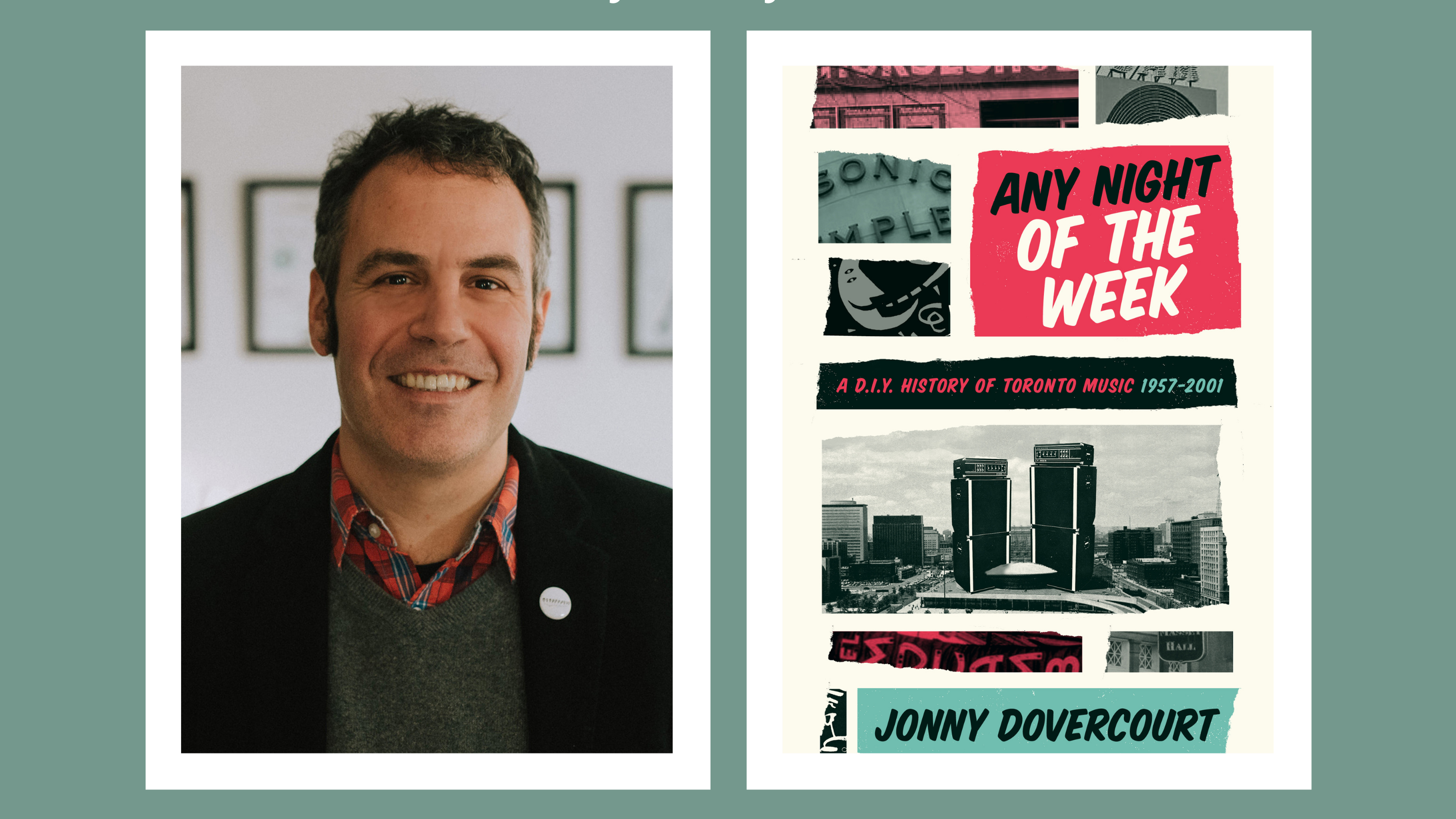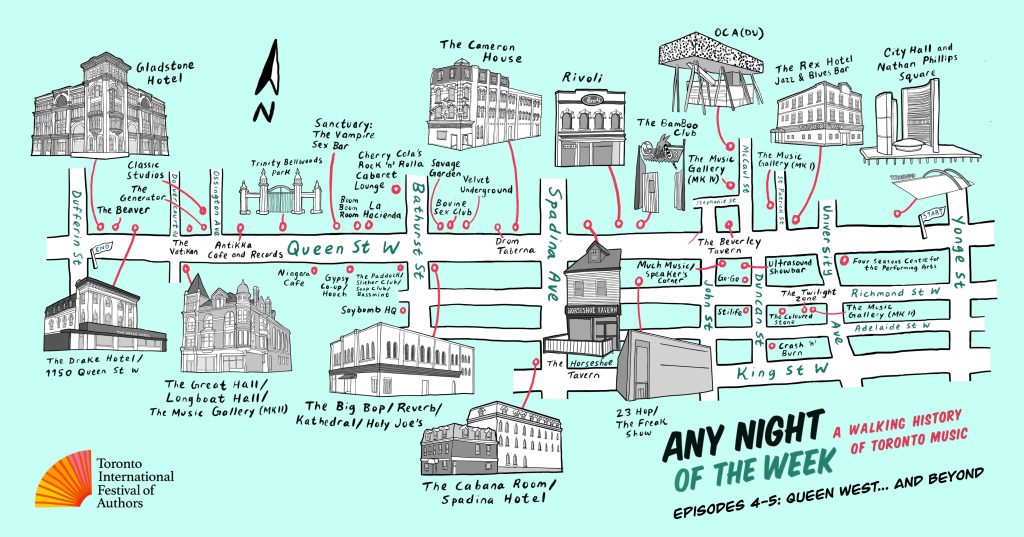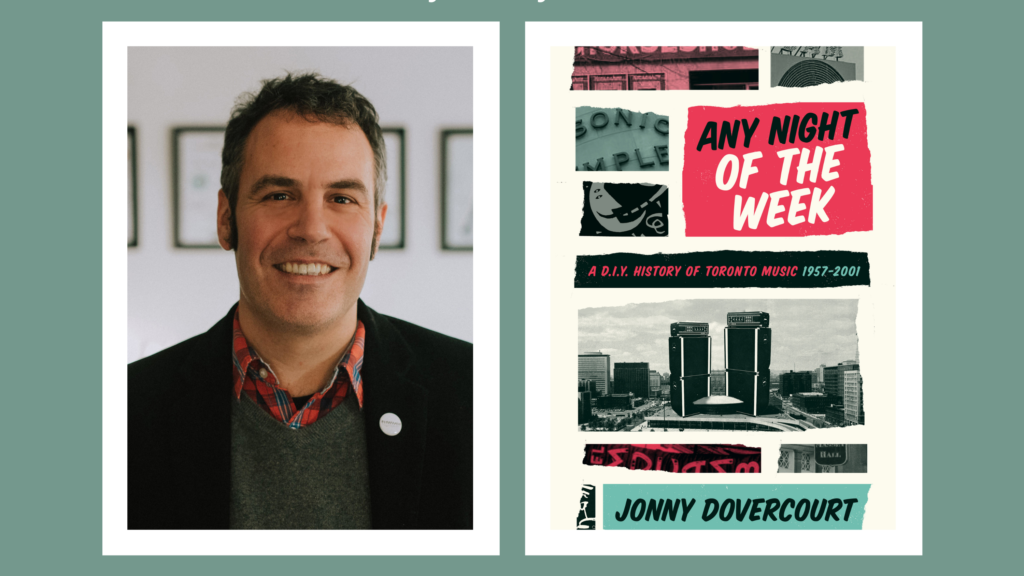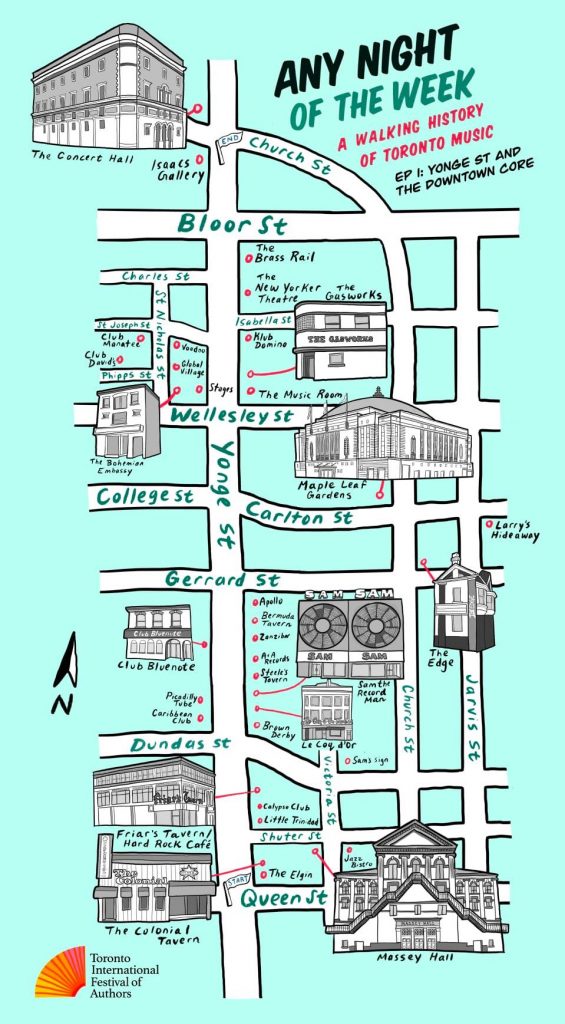Any Night of the Week: A Walking History of Toronto Music

Based on Any Night of the Week: A D.I.Y. History of Toronto Music 1957-2001 (Coach House Books, 2020), this podcast takes the listener on a virtual walking tour through Toronto’s most musical neighbourhoods, with stops at key sites in Toronto’s music history. Author Jonny Dovercourt illuminates how the various hotbeds of the music scene migrated through different neighbourhoods throughout the city, as clusters of music venues, sometimes along a single street, fostered new scenes and movements. Get your copy of Dovercourt’s book Any Night of the Week: A D.I.Y History of Toronto Music here.
Second Season
Listen to the three new episodes below!
Episode 2.1: The East End
This virtual walking tour will take listeners on a TTC transit trek east from downtown, with stops at the Opera House at Queen East – revisiting the vibrant all-ages indie scene of the ‘90s – then up to the Danforth to visit the Danforth Music Hall – one of Toronto’s most beloved mid-sized concert halls – as well as mainstays the Only Cafe and Hirut, and dear departed spaces like the Roxy Theatre and Spectrum Nightclub.
Episode 2.2: Scarborough
This sonic exploration of the east side of the city continues on into Scarborough, shining a light on the lesser-known musical history of the inner suburbs. We’ll visit sites such as the Knob Hill Hotel and curling club the Broom and Stone – where acts for the ‘60s Yorkville scene played for suburban teens – and the shopping malls and high schools that cultivated old-school hip-hop, while exploring how live music can pop up in public space in unexpected ways.
Episode 2.3: Dundas West
The last virtual walking tour of this season will follow Dundas Street West – the latest contender to rival Queen, College and Bloor Streets as Toronto’s liveliest music strip – on a west-end odyssey. Starting at Bathurst and wandering west to the hipster corner of Dundas & Ossington – where small yet mighty independent venues The Dakota Tavern, The Garrison and The Painted Lady are emerging from a fight for survival – this episode will also explore the vibrant Latin and global music scenes supported by Lula Lounge, the up-and-coming arts scene on Sterling Road, and former folk hub Hugh’s Room. The episode will also address the imminent change of the Dundas street name – which came from an 18th century anti-abolitionist – in an interview with Andrew Lochhead, the local activist who spearheaded the petition to change the name.
First Season
Three beautiful maps were created by Daniel Rotsztain (@theurbangeog) to accompany the first season episodes, so be sure to take a look at those below while you listen. You can also purchase prints of the maps here.
Episode 1.1: Yonge Street and the Downtown Core
The history of Toronto’s music scene starts on Yonge Street, though the garish commercial strip has long since withered away as a hotbed for live music. Walking north along Yonge from Queen up to Bloor, we take a chronological and geographical trip through history, from the debut of the New Symphony Orchestra at Massey Hall in the ‘20s, jazz at the Colonial Tavern in the late ‘40s, the heyday of rock’n’roll and R&B on “the Strip” in the ‘50s and ‘60s, and community spaces for Caribbean and LGBTQ+ musical expression; continuing through the sleazy hard rock era of the ‘70s, punk rock and new wave on the edges of the core in the late ‘70s and early ‘80s, and the birth of Canadian hip-hop at the Concert Hall in the mid-’80s.
Episode 1.2 & 1.3: Urban Villages
Urban villages are walkable, mixed-use, pedestrian-friendly neighbourhoods that significantly improve the quality of life in big cities – and they’re a big part of Toronto’s unique character. They’ve also played a big role in the evolution of our music scene. This two-part episode takes us on a trek through four such interconnected villages and the hyper-local music scenes that defined them. Part I of Urban Villages is a lazy wander through the bohemian folk and psych-rock scenes of ‘60s Yorkville and west towards the poetic blues, roots, and alt-rock of The Annex in the ‘80s and ‘90s. Sites visited include the long-lost Riverboat Coffee House, Varsity Stadium, Trinity St. Paul’s Centre, The Brunswick House, the Tranzac and Lee’s Palace.
Urban villages are walkable, mixed-use, pedestrian-friendly neighbourhoods that significantly improve the quality of life in big cities – and they’re a big part of Toronto’s unique character. They’ve also played a big role in the evolution of our music scene. This two-part episode takes us on a trek through four such interconnected villages and the hyper-local music scenes that defined them. Part II of Urban Villages starts with a stroll along Spadina Avenue, looping through multicultural Kensington Market and along College Street towards Little Italy, connecting bluesy, post-Yorkville bohemia of the ‘70s with pre-millennial indie, punk, reggae and electronica. Iconic venues include the El Mocambo, Sneaky Dee’s, The Silver Dollar Room, Grossman’s Tavern, Graffiti’s, Ted’s Wrecking Yard and the Mod Club Theatre. 
Episode 1.4 & 1.5: Queen Street West
Queen Street West is arguably Canada’s most important countercultural main street, and may even be North America’s. Queen West was a quiet, mostly forgotten commercial strip until the punk rock, new wave and reggae explosion of the ‘70s, and it really came to live in the diverse, inclusive, alternative ‘80s – eventually becoming a main hub for the Canadian music industry in the ‘90s. This two-part tour will take us west from University all the way to Gladstone Avenue. The first half explores the origins of the Queen Street scene at its most eastern end – “Classic Queen West” – as well as the birth of Clubland just south on Richmond. Historic sites include The Rex Hotel Jazz & Blues Club, The Music Gallery, The Beverley Tavern, Crash ‘N’ Burn, The Twilight Zone, 23 Hop, the BamBoo Club and the Rivoli.
Queen Street West is arguably Canada’s most important countercultural main street, and may even be North America’s. Queen West was a quiet, mostly forgotten commercial strip until the punk rock, new wave and reggae explosion of the ‘70s, and it really came to live in the diverse, inclusive, alternative ‘80s – eventually becoming a main hub for the Canadian music industry in the ‘90s. This two-part tour will take us west from University all the way to Gladstone Avenue. Part II follows Queen West as the subcultural strip pushed further west past Spadina — and towards more glorious black-clad griminess. Venues visited include The Legendary Horseshoe Tavern, the Cabana Room, The Cameron House, Drom Taberna, the Velvet Underground, the Bovine Sex Club, The Big Bop/Reverb, The Great Hall, the Drake Hotel and the Gladstone Hotel. The tour concludes with a consideration of where else future tours might go – such as the East End or Toronto’s inner suburbs. 





